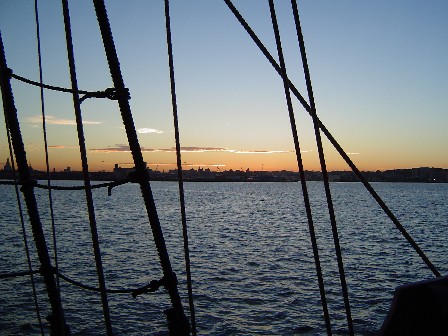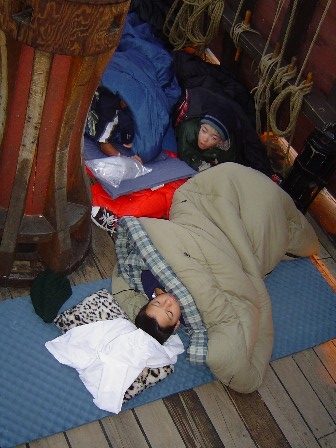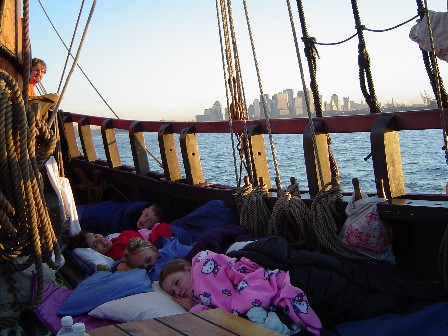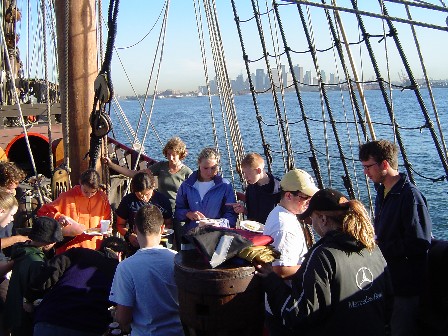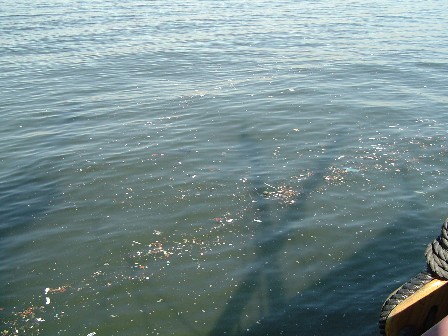 |
|
Daily
Log, September 22
|
|
THANK YOU FOR YOUR E-MAIL; SEE RESPONSES BELOW (Sorry, but we will not be able to send individual responses from the ship.)
|
|
Latitude 40o 39.9’; Longitude 74o 01.6 On Bay Ridge Flats, New York Harbor. What a beautiful view in a beautiful harbor.
The dawn came with an orange glow over Brooklyn, the perfect complement to our sunset last night, and a pleasant night in the Harbor. The forecast for today is temperatures in the 80s F, with light winds from the north. Mr. Weisse, who hails from Boston, terms it ‘a scorcher,’ with a thick Boston accent. Those of us from down south might look forward to a pleasant afternoon. Either way, we will weigh anchor about 1000 and head north with the flood current.
One noticeable difference in New York Harbor in the last few years is the dramatic increase in ferry traffic. High speed ferries make the run through the Harbor, across Raritan Bay and into New Jersey, running from pre-dawn, late into the night. Smaller ferries and water taxis run continuously back and forth between New Jersey and Manhattan, Manhattan and Brooklyn, and up both the North and East Rivers. But the most significant difference in New York Harbor of the last few years is the improvement in water quality. The first sign is the reduction in floating trash and debris, compared with conditions into the 1990s. The more important sign is the cleanliness of the water. This has come with improvements in the control of petroleum and hazardous chemicals, for which even minor spills are no longer tolerated, and equally important improvements in the treatment of sewage from land. The next major are of improvement needed is in the control of storm water run-off. Heavy rains send oil and chemicals from our streets, and all kinds of trash from our gutters running right into the Hudson River and New York Harbor; this is true from the upper Hudson right down into the New York City metropolis. The more we can get people out to, on and in the River and Harbor, the sooner we will see more improvement in our waterways.
|
|
At Anchor off Georges Island, Haverstraw Bay Latitude 41o 13.8’; Longitude 073o 57.0 The weather forecast is pleasant, with a high pressure system dominant in the area through Friday – this makes the choice of an anchorage quite simple: all we need to look for is sufficient water depth, well removed from navigational channels. In the highlight of our voyage, the student crew presented the results of their research tonight, with quite a spread of research topics. Each student presented a three- to five-page summary of their research topic, with an explanation of their methodology and objectives, the principal findings, and suggestions for future research. This was followed by questions, comments and interesting discussions with the rest of the crew about each project. It was quite a night, as you may see by going to the Learning Pages of our website. We have received inquiries and greetings by e-mail, and while unable to answer each e-mail individually, would like to provide general responses to some of the questions here.
2. The Half Moon will arrive in Albany at the Corning Preserve at 1100 on Wednesday, September 29, for an arrival ceremony recognizing the students who have sailed with us. The ship will remain in Albany for two weeks, open for tours from October 2 to October 15. Weekdays are for school group tours scheduled by the Albany Visitor Center, and weekends are for the public (open 10:00AM to 4:PM Saturday, Sunday and Columbus Day).
We will answer other questions in future logs. |
|
|
